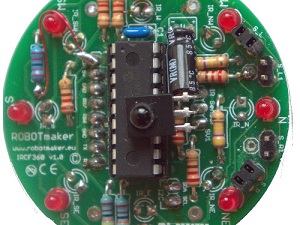
“This will be great – the ops board love cost savings and this is the biggest one anybody has proposed this year, more than a quarter of a million dollars! This could be the start of them taking us more seriously.
John was ebullient as he walked across the elevated walkway to the executive wing of Uni Corp., hardly pausing for breath and certainly paying no attention to Tracy, who was puzzling over a page of bar charts. He had taken the role of Head of Corporate Real Estate after his predecessor had resigned, although everyone thought they had been asked to leave.
“We should cross-check this data before we finalize the plan” Tracy said as they badged through the large, silently sliding frosted door, the large dark rugs no doubt helping to subdue the occasional sounds of activity.
John hesitated on one of the larger, deep blue rugs: “I thought you had double checked the infrared sensor data thingies…?”
“Passive Infrared – PIR – sensors” Tracy corrected. “Yes, the system isn’t reporting any faults, and the results are plausible.”
“But…?” prompted John. “Remember those simulations we ran based on the profiles managers completed? I know that we need to be careful with survey data, especially compared to the simple facts we get from the PIR occupancy sensors, but there’s something funny about the accounts payable team: even though all the other teams in the building came out fairly close in the simulation to their measured occupancy, the A/P team were different: they had higher occupancy in the simulation.”
“That’s why we measure the facts! Surveys only go so far.” It was clear that for John that finished the conversation and before Tracy could even acknowledge the potential truth of his statement, John had already set off again across the lobby and through the open door into the board room.
“Thanks for that Tracy – you explained the opportunity really clearly and they all got it – we have a project!”. John was leaning back in his office chair, while Louise stood facing the window. He continued “Next time, though, you probably shouldn’t try to explain the simulations to them – it’s like rocket science and they start to question our recommendations because it looks so complicated. Keep it simple.”
After a moment, Tracy said “But what if we’re wrong?”
John sat up and with one hand span a spare copy of the handouts they had brought back with them from the meeting so that it was facing Tracy.
John suddenly looked very serious: “This report says the A/P team have 50 more desks than they need – true?”
“Yes”
“And you’ve checked the data that result was based on, and there’s nothing wrong with it?”
“Not that I can see, no”. Tracy was looking straight at John now.
“And the observation data didn’t contradict these results?”
Tracy hesitated slightly “Observations are really hard to generalize from. But no, they didn’t contradict the PIR data.”
“So the only thing that’s making you uncertain is that a survey completed by Judith suggests that they need more desks than they really do – right?”
“I suppose that’s one way of putting it, yes”, Tracy conceded.
“Well, Judith is always complaining about not having enough space. She’s probably just over stated what they need because she thinks we’ll shave some of it off anyway. I want you to start work with Peter first thing in the morning and turn this project approval report into a program plan to do the restack and vacate the 10th floor, like the ops board asked us to. And before Judith finds out and tries to sabotage us. Now why don’t you go home and get some rest.”
“Good morning John – large hazelnut soya latte?”. Tracy had been waiting just a few minutes in the foyer with John favourite coffee. It was 7:47am, and John was nothing if not consistent.
Now he was suspicious too: “What have you done?”
“I might have saved you your job. We’ve got to cancel the restack project.”
“What!? You better be joking!”. John’s voice was noticeably raised and Tracy guided him through the double doors and over to a quieter corner booth in the café.
“I’m not joking. I didn’t go straight home last night. I looked over the simulation results again. I looked at Judith’s responses. I compared them to the other surveys, and to other teams that we usually assume have similar work styles to the A/P people. I couldn’t find anything that even slightly supported our hypothesis that Judith had somehow fiddled the survey.”
“So I went back and looked at the PIR data. I tried to imagine how it could be under-measuring. I checked everything again: I looked at the occupancy curve through the day; I looked at the average occupancy in the five zones; I looked at snapshots of occupied desks at half a dozen different times of day. It all looked fine. I even went over there to see if all the sensors were still there!”
“But when I was there I noticed that one of the under-desk-sensors had been turned around. Obviously someone had taken things in to their own hands to avoid being ‘measured’. But it got me thinking. That sensor has been reading ‘no occupancy’ for however long it has been turned around. But we didn’t notice that. What if there are other sensors that have been turned around? I checked dozens all down the office and there weren’t any others. So I got in the lift at the back of the building and pushed “1” to come back down to my desk. Guess what?”
“What?” John was taking occasional sips of his coffee and looking a curious mixture of puzzled and irritated.
“The bulb has gone on the first floor button in the rear lift!”
“Sorry, what’s that got to do with us pulling this quarter of a million dollar saving program?”
“I realized, that bulb could have been out for ages. We should have had an alert from the building control system but we haven’t. No one on the higher floors probably ever presses that button – they’ll either be going up to their floor or down to the ground floor to get out. The only people that would use that button would be from our floor, but we mostly use the stairs, or the main lifts in the lobby.”
“So if that bulb has been out for ages, but no one has noticed, what if we had PIR sensors that had been out for ages, that the system had failed to detect were faulty, and that we hadn’t noticed?”
“So I went back to the data – not the PIR reports but the raw data from the individual sensor. And there it was – obvious once I knew what I was looking for: over 40 of the sensors have *never* provided any presence events! I located three of them, went back and physically checked they were still there, and they were: correctly positioned, powered, all good. I waved my hand in front of them to be certain to create events and then went back and waited until the end of the hour for the data to come through – nothing!”
“The data looks plausible because the sensors that aren’t reporting are distributed throughout the floor. If we even noticed those desks weren’t used we would probably have just assumed they were unpopular or something.”
“But I think Judith was straight forward with us in her survey: we should rely on that to estimate her space needs until we can get the PIR issue resolved.”
John looked deflated. “What am I going to tell the Ops Board? I’m going to look like a fool.”
“Tracy, do you have a minute? This is Amanda, our COO”. John was standing in the aisle next to Tracy’s desk accompanied by Amanda Jacobs, who, despite her reputation for being ruthless had a warm friendly smile as she reached out her hand to shake Tracy’s.
“Hello Tracy, it’s nice to meet the person who saved us from a costly mis-step.”
“Oh, nice to meet you too, and thank you.” Tracy was standing now.
Amanda continued “It was really good that John came back to us once you realized the problems with the data. It takes courage to challenge something everyone else wants to happen. And it would have been quite disruptive to go through the restack only to find ourselves having to redo significant parts of it and likely not being able to achieve the savings we had planned for. What made you go over the data again?”
Tracy explained “We had two different sources of the data, which agreed for most departments but not for the A/P team. The data from these sources was of a completely different nature, so we couldn’t use it to directly check either source, and one of the sources was based on surveys which are typically not very reliable. But I wasn’t comfortable that we had this one team that was different, and I wanted to understand why.”
John went on “Tracy likes to really understand the data behind our analytics, and I don’t know what we would do without her. Tracy, would you like to tell Amanda what you’re working on at the moment?”
“Sure – I’m looking at how we can update our measurement infrastructure to include at least two independent measures for each thing we are interested in. For example, not just rely on the PIR sensors to measure which desks are in use, but also use data from the IT network to see which desks have a laptop in the docking station. We can then correlate and compare these two sources to get a more accurate picture of what’s going on, and – perhaps more importantly given what’s happened – identify when either system develops a problem.”
Amanda was intrigued “So does that mean that the data we have been using so far isn’t accurate?”
Tracy glanced at John before answering: “Unfortunately none of the data we have is 100% accurate – we are constantly looking for ways to improve the reliability of the systems, and their accuracy. This will be another step toward more accurate data. What’s exciting though is that because the data is more accurate and more reliable we won’t have to allow as much contingency in the future. Currently we need to add more than 40% to measured occupancy to accommodate the underlying issues with the PIR data and bring the risk within our corporate tolerance. However, once we have multiple measures that we can cross-check, I expect we can reduce that contingency to below 10%.”
John smiled. “Based on some initial testing Tracy has been doing, we think we might be able to identify a minimum of 20% realizable space savings in our larger buildings. Across the portfolio that would translate to about seventy million dollars a year in savings.”
Amanda grinned: “I’m very much looking forward to our next Operations Board meeting.”
